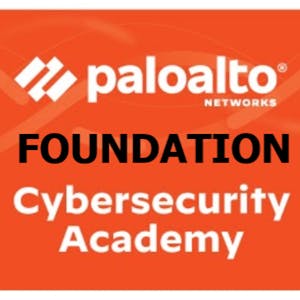Embark on a comprehensive journey through the cybersecurity landscape with the Palo Alto Networks Cybersecurity Foundation course. Delve into the fundamental principles of contemporary cybersecurity, understanding the evolving threat landscape, and mitigating attacks on enterprise networks and mission-critical infrastructure. Through a blend of theoretical knowledge and practical skills, students will learn to set up and configure security zones, authentication, and policies on next-generation firewalls.
The course encompasses an array of critical topics including modern computing trends, cloud computing challenges, cyberattacks and their business impact, attacker profiles and motivations, malware types and analysis, botnets, Zero Trust design principles, perimeter network security strategies, and much more. Furthermore, students will explore the capabilities of the Security Operating Platform, secure the enterprise with NGFW and Traps endpoint protection, and safeguard the cloud with Prisma Access, SaaS, and Cloud. The course culminates with insights on securing the future with Cortex Data Lake and XDR, and implementing two-factor authentication and trusted application configurations on the NGFW.
Upon completion of this course, students will emerge with a comprehensive understanding of cybersecurity concepts and the ability to navigate the dynamic cybersecurity landscape with confidence and proficiency.
Certificate Available ✔
Get Started / More Info
The course modules cover a wide range of topics, including cybersecurity landscapes, threats, attack types, security models, and the Security Operating Platform, providing students with a comprehensive understanding of cybersecurity principles and practical skills.
Module 1 provides an overview of the course and explores the importance of cybersecurity. Students delve into the Cybersecurity Foundation Course Syllabus, Cybersecurity Foundation Course Textbook, and the role of a Certified Cybersecurity Entry-level Technician.
Module 2 delves into the future of cybersecurity, NIST Cyber 101, modern computing trends, cloud computing challenges, compliance, cybersecurity jobs, and more. It also includes a module quiz and CERT/SANS assignment.
Module 3 delves into cybersecurity threats, social engineering, cryptocurrency mining, attacker profiles, high-profile cybersecurity attacks, Wi-Fi configuration and attacks, advanced persistent threats, and security threat actors. It also includes a module quiz.
Module 4 explores various attack types and techniques such as malware, exploits, bots, botnets, spamming, phishing, distributed denial of service, and APTs. It also includes a module quiz and state of malware reports.
Module 5 provides insights into cybersecurity models and design principles, including security models, securing the datacenter, zero trust, perimeter-based security, and security compliance. It also includes a module quiz.
Module 6 focuses on the Security Operating Platform, covering the setup of Palo Alto Networks NGFW, the PAN OS Administrator's Guide, next-generation firewall overview, VPN technology, and concludes with a final exam.
This course equips you with the essential skills needed to become a successful cybersecurity analyst, covering digital forensics, incident response, penetration...
The Digital Forensics Concepts course teaches students about legal considerations, scientific principles, and practical techniques for identifying, collecting, and...
Prepare for a career in cybersecurity with Microsoft's Cybersecurity Analyst program. Gain hands-on experience and industry-recognized certification to protect organizations...
Securing the IoT Landscape: From Inception to Architecture offers a comprehensive understanding of IoT security, covering device identity, preventive measures, incident...